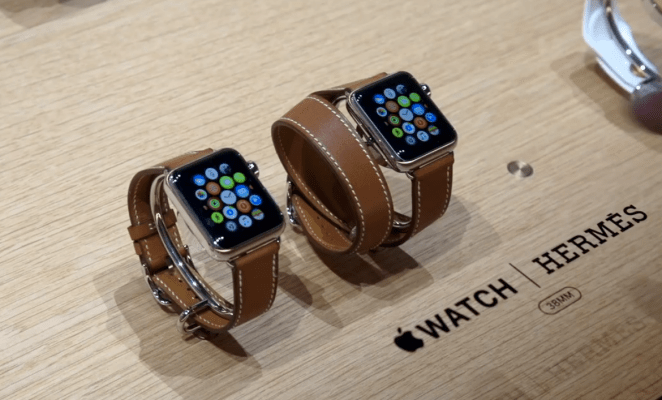If you, like Andy Sachs, don’t believe that fashion is important, Apple just gave you a nudge in the right direction. While not many particularly cared, the first Apple Watch Hermès is a harbinger of something quite interesting.
First, a bit about the watch. The only real difference, aside from the fancy new faces, is a leather band that comes in two permutations, single and double. This is important. The Hermes “double” band – the band wraps around the wrist twice before closing – comes from the company’s iconic Cape Cod line.
This silver watch, released in the junk bond haze of 1991, was supposed to hearken back to the days of clam bakes, gimlets, and angry, drunken arguments on a wraparound veranda at the family estate. It was designed for a watch with a Tonneau case aka a barrel case, so called because of its bulging sides and rectangular shape. The band is also easily removable on the original watches, allowing the fashion-forward to swap it out with other colors.
In other words, this band hit on all fashion cylinders. It had a pedigree, it was originally made for a watch that was the size and shape of the Apple Watch, and, if anyone snorted at a fashionista’s choice of watch they could simply say “My watchmaker moved my Hermès band over to this silly smartwatch just to see what it would look like. I’m going to have him replace it back post-haste. I’m quite embarrassed.” All of these concerns, while unimportant to the vast majority of humankind, are considerations that luxury manufacturers have all the time.
In short, this band was an experiment. Hermès sells their watches for about $3,000 and higher. Up until now they wanted to associate themselves with smartwatches in the same way caviar salesmen wanted to hang out with ketchup manufacturers – perhaps there was some overlap but dammit if they’re going to stoop to putting sturgeon roe into little packets and serve them at McDonald’s. But they did, and for a very good reason.
As I’ve said before, luxury brands are moving into the future but with more difficulty than we imagine. Their old customers are dying. Those old customers were proud of their Luddite ways, preferring a Cape Cod over a Timex and a trilby over a gimme cap. Now, however, the rich millennials are popping up and their parents are intrinsically unable to describe the value proposition of a $12,000 Rolex because they’re too busy on the smartphone. Luxury makers have to educate this new generation all over again, from telling them the twee origin tale of the Birkin bag to convincing them not to buy an Apple Watch – and if they do buy an Apple Watch to buy the gold one with the Cape Cod band.
Think of this odd pairing of Apple and Hermes as a gateway drug. If Hermès can fool the consumer that their band is superior to Apple’s models, they can also convince the consumer that their fashion-forward scarves are better than a $5 scrap of silk from H&M and that a relationship with a brand Hermès – not the products themselves – will make them better people. It’s how it’s been done since the 17th century and that won’t change simply because the bauble buzzes instead of ticks.
Why is Apple hopping on the luxury train? Because tech is the new status indicator. What laptop you carry, what phone you own, what smartwatch you wear is as reliable a signal of your status and position as dirty dungarees and a hobo bindle were during the Great Depression. While I still say OS X is the best operating system and in a tie with Linux for chunks of code that changed the world, the average buyer doesn’t care about that. What they want is a laptop that works well, looks good, and tells the world that they are a special person with a particular set of skills. Once upon a time – not too long ago, actually – the accouterments that defined those skills were made of bone and silk and crepe – the wardrobe of the fashion-forward. Now they are made of steel and silicon and, in this case, fine leather.
